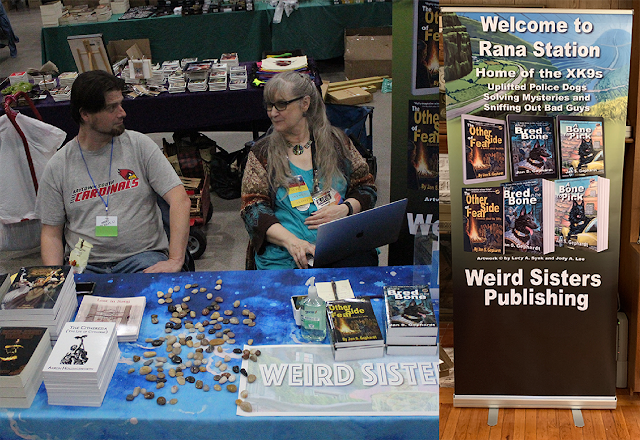I’m a little over a week back from my last in-person science fiction convention. It truly was an Archon to enjoy. Archon 45 offered at least a little bit of everything I’ve come to love about sf “cons.”
This was, of course, far from my only Archon – and if you follow my blog, you know I’ve written about it in the past. You might enjoy some of my past posts about the Art, the Artists, the Writers, the Costumes, the anticipation, and my appreciation of their sensible Covid protocols last year. There were some great costumes this year, too, but I didn’t get very good pictures of any. For better photo coverage, take a look at Elizabeth Donald’s blog post, “Archon 45 is a smash!”
An Art Show to Enjoy
The Archon Art show is always a highlight for me. Not only do I always make a point of showing my artwork in the show, but I also enjoy looking at the strong showing of excellent art that usually shows up.
I reserved two panels, and I think I made a pretty decent showing. Sold a couple of pieces, which is an accomplishment (paper sculpture is hard to price at sf con levels). Cat Conrad was this year’s Artist Guest of Honor. It was fun to see him, and chit-chat a bit. He and I have been friendly acquaintances for a long time.
Many other “regulars” and favorites showed work, too. They added to the elements that made this an Archon to enjoy. Kansas City friends Rachael Mayo and Allison Stein came and brought their wonderful artwork (including gorgeous new 3D work by Rachael Mayo). St. Louis-area artists John E. Kauffman, Craig Skaggs, Brent Chumley, Mike Cole, and Eddie Wilson had Artists’ Alley booths, as well as an Art Show presence. Peri Charlifu, Arden Ellen Nixon, Theresa Mather, Sarah Clemens, and many more also had art in the show, so it added up to another great year of artwork at Archon.
Cat Conrad’s artwork is a screen-grab of publicly shared images on his website, © Cat Conrad. Jan S. Gephardt’s paper sculpture is ©2012-2022.
An Art Display to Especially Appreciate
But of all the artists in the show, I have to say I really thought Lucy A. Synk brought an unusually wonderful display. And that’s not just because about two-thirds of her panels featured artwork I commissioned.
it’s because there was an unusual quantity of gorgeous original oil, acrylic, and mixed-media paintings, and because several were impressively big. The show-stopper had to be her magnificent Oak Park Halloween painting, which I once blogged about. She also brought some of her mixed-media planetscapes, including the one that won an award at Chicon 8.
Of the “Rana Station” art, in addition to Jogging in Gaudí Park, First Responder, and Hildie, she also brought several “XK9 Portraits.” An all-around outstanding display! But don’t just take my word for it. She won Best of Show, Best Pro Artist, and tied with other artists for Fan’s Choice in the voting at Archon.
 |
| All of the artwork on Lucy A. Synk’s panels is ©2019-2022 by Lucy A. Synk. |
Panels and Fellow Panelists
For me, a highlight of any science fiction convention is attending panels. In that way, too, it was an Archon to enjoy. I had a fun and lively group of artists, both in the audience (including Rachael Mayo, the ultimate word on dragons) and on the panel for “Do People Still Like Dragons?” Brent Chumley, Allison Stein, and Lucy A. Synk officially joined me on the panel. It was mostly about the current state of the art market for fantasy & sf artists. But we quickly established that yes, people do still not just like, but love dragons. They are in no danger of going away.
I got to be the moderator for all of the panels I was on, which I very much enjoy. I like being able to make sure that the audience is involved and able to ask questions. And after a career in teaching I know how to balance out the speakers so everyone gets a turn.
Maintaining balance (and keeping the conversation mostly in English laymen could understand) was my primary challenge for the “Current and Future A.I.” panel! My co-panelists, Bryce Meyer and Jack Glassman are experts in the field, whom I’ve had the pleasure of moderating before. Both are brilliant – and very enthusiastic. They love above all else to talk about their field. But they’re also respectful, and they take a cue pretty well.
 |
| Photo ©2022 by Tyrell E. Gephardt. |
A Great Note-Taker for a Co-Panelist
The downside of being the moderator is that it’s very difficult to take notes. We had a wide-ranging conversation at the panel titled, “Children’s Cartoons and the Adult Viewer.” My family and I have enjoyed a number of these shows, such as Inside Job, Lower Decks, Centaurworld, She-Ra and the Princesses of Power, and The Owl House. My co-panelists were Nick Butcher, Rhiannon Gonzalez, and Matthew Edward Munro. They brought ideas and reactions about a range of other shows. So did several well-versed audience members. The conversation included straight-up Anime shows and game tie-ins, as well – but unfortunately I can’t tell you their titles.
As the moderator I also couldn’t take notes on “Best Indie Authors of Science Fiction & Fantasy,” either. But fortunately, I didn’t have to! Co-panelist and the other author on the panel, Rachel Neumeier not only took great notes, she turned them into a blog post! For my list, I drew heavily on a post I’d written last year, “Indie Women of Science Fiction.” You’ll see that list included in Rachel’s post, but my write-up expands a bit more on each author, so both might interest you.
I don’t believe Rachel mentioned Jerry Boyd, however. He’s the creator of the “Bob and Nikki” series (now up to 28 titles) Two of our fellow panelists, Cheryl Medley and Linda Wyatt were not writers, but avid readers, who like to specialize in Indie writers for several reasons. Cheryl wore a “Bob’s Saucer Repair” T-shirt (the title of “Bob & Nikki Book 1”) to the panel, but did complain that Jerry had failed to put his name on it anywhere!
 |
| See credits below. |
My Reading
I always like to do a reading at science fiction conventions I attend – and I also love to go to readings, as anyone who’s followed my blog for a while can attest. Over the years I’ve written about authors’ readings at DemiCon, ConQuesT, several at SoonerCon, at Worldcons, the NASFiC SpikeCon, FenCon, and of course, at Archon. Having a chance to share my work with fans was guaranteed to help make this an Archon to enjoy!
This year, however, I didn’t have much advance-time to publicize my reading at the convention itself. It was set for the very first night on the con. So I used social media beforehand, to alert people. It must’ve worked! Most of the people who came were there for my reading. I was originally set to read with D. A. Roberts and Elizabeth Donald, but Roberts had to cancel his attendance.
I had therefore planned to read a slightly longer selection (essentially Chapter Two of Bone of Contention – I’d read Chapter One last year, and several of my listeners were there last year, too). But we ran into technical difficulties that made us run late, and I didn’t have time to read all of mine. I plan to serialize it, plus the next several chapters after that, for my Newsletter subscribers in coming months, however (in case you’re curious).
Elizabeth was able to read all of hers, though! It was a wonderful short story called “Sisyphus,” from her Setting Suns anthology.
 |
| Photo of Aaron Hollingsworth and Jan S. Gephardt by Tyrell E. Gephardt. |
Hollingsworth and Weird in the Dealers Room
I wrote quite a bit in my post just before Archon this year about my pre-con publicity, my special banner and table-cover, and my plans for sharing a dealers table with Aaron Hollingsworth. Most of those plans worked out pretty well.
I especially liked the chance to share Chapter One of my book What’s Bred in the Bone with prospective readers via a QR Code. A surprising number of people took a postcard, planning to read Chapter One that night and, if they liked it, come back the next day. Imagine my delight when they actually came back the next day to buy books! That definitely made it an Archon to enjoy!
I had a new toy, this time, a Square Terminal. It made things a whole lot easier. And it even prints out a paper receipt! I think exactly one person asked for one, but still! It has Weird Sisters Publishing’s logo on it and everything. Pretty nifty.
An Archon to Enjoy – And I’m Already Looking Forward to the Next!
My Archon experience was good enough (and made enough money for me) to decide that Weird Sisters Publishing will have a dealers table from now on. Next spring, when the conventions start up again, I’ll actually have more titles (though people will have to wait a bit longer for Bone of Contention).
We plan to sell my sister’s two Deep Ellum stories as a single printed book, titled Deep Ellum Duo. We’ll also have print editions of the four novels in my late brother-in-law Warren Norwood’s Windhover Tetralogy. We’ll release all of these books this winter, so stand by for further updates on that!
All in all, as you probably have gathered, it was totally an Archon to enjoy. I’m already looking forward to next year!
IMAGE CREDITS
Some of the photos and illustrations I’ve used here have also turned up in other posts or on social media. Anything not credited is a photo or montage of photos that I took and assembled. I assembled the other montages, too, but the images in them have several sources.
Both Archon 45 headers are courtesy of Archon 45. Tyrell E. Gephardt and I both took photos of my Art Show display. I’m not sure whose shot this is. Artwork shown in the photo is ©2016-2022 by Jan S. Gephardt. The gallery of Cat Conrad’s artwork is a screen-grab of publicly shared images on his website. His artwork is © by Cat Conrad.
All of the artwork on Lucy A. Synk’s panels is ©2019-2022 by Lucy A. Synk. I took the photos with her permission (indeed, her cooperation). I’m using them here with her permission.
The photos of me at the Cartoons panel and with Aaron Hollingsworth at the Hollingsworth & Weird dealers table are both ©2022 by Tyrell E. Gephardt. I’m using them here with his permission.
The images of the “Indie Women of Science Fiction” are courtesy of the authors’ websites or social media, via my blog post. This montage was originally published (with full credits) on The Weird Blog and the two “Artdog Adventures” blogs. The artwork on the book covers with the QR codes in the last picture is ©2019 and 2020 by Jody A. Lee.

















